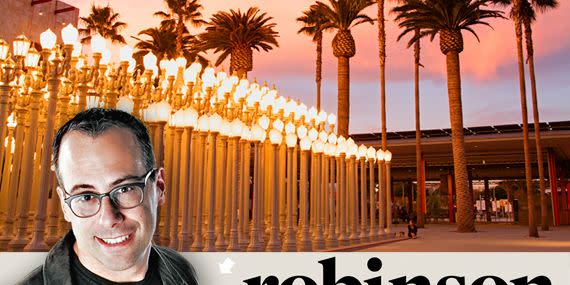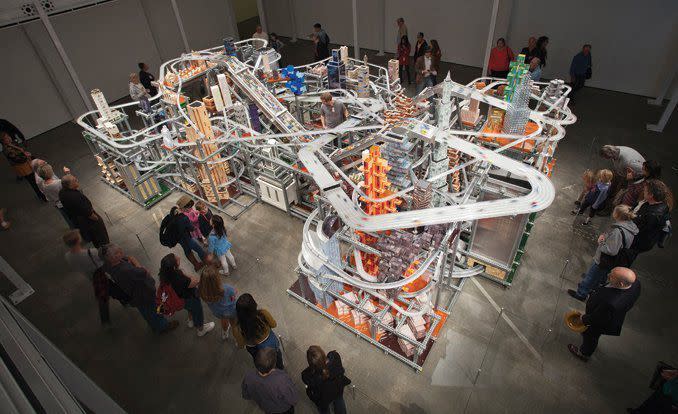Aaron Robinson: Chris Burden Isn't Your Typical Car Artist



In artist Chris Burden’s first automotive piece, nails were hammered through his palms and into the roof of a Volkswagen Beetle as he lay face up, spread-eagle over the car’s rear. Burden and Bug were then pushed halfway out of a garage in Venice, California, as the engine ran at redline, symbolically “screaming for me,” he writes in the work’s published description. After two minutes, the car was pushed back in and the garage door closed. Burden called it “Trans-Fixed.”
It was 1974, during the zenith of masochistic performance art. For his 1971 graduate thesis from art school, Burden spent five days stuffed in a book locker. He also had a friend shoot him in the arm with a .22 rifle in a work titled “Shoot.” Then there were the live electrical cables he touched to his chest.
For perhaps obvious reasons, you don’t see his work in the Automotive Fine Arts Society tent at Pebble Beach, where highlights of motoring’s golden age are rendered lovingly and repeatedly in oil, tin, and acrylic. But at 66, he is no less enthusiastic about cars.
Of “Trans-Fixed,” Burden says, “It wasn’t an anti-car statement at all, it was [for] a love of Volkswagens, to be honest. I had a whole bunch of them in college, and you could buy them for two or three hundred dollars.”
And the nails? “Surprisingly,” he says, perhaps undercutting a basic tenet of Christianity, “they didn’t hurt, for some reason.”
In the late ’70s, after building a 100-mpg single-seater called “B-Car,” Burden abandoned what The New Yorker labeled his “theater of passive-aggressive cruelty” and became a sort of master toy maker. He hitched a 250-cc Benelli motorcycle to a 6000-pound iron flywheel for a piece named, appropriately, “The Big Wheel.” He built elaborate miniature battleships and sprawling landscape dioramas out of found objects and vintage Erector sets. Mechanized war was a consistent theme. My favorite is “When Robots Rule: The Two Minute Airplane Factory,” a fully automated assembly line designed to churn out squadrons of wood-and-tissue-paper model airplanes. Sadly, he never got it working perfectly.

Burden’s cluttered mountaintop realm sits high above the hippie Los Angeles enclave of Topanga Canyon, where the 1970s blew a radiator hose and decided to settle permanently. On a stroll of his property, we find in the scrub a trio of Citroën 2CV vans and a pair of Daihatsu Rockys, plus some immobile Subaru Brats and a yellow ’74 Porsche 914 that Burden is planning to eventually use in an art installation. The 2100-pound Porsche will hang from the near end of a beam, balanced by a 365-pound meteorite he bought in South America.
“I have a 911, but somehow the 914 is so bizarre and so German and awkward, too. It just seems to fit with the meteorite better. I can’t tell you why. There’s some kind of relation there,” he says.
It’s all about energy and symmetry and mass—or something. Burden doesn’t seem too interested in dissecting the deep meaning of his projects. Maybe there isn’t any, but I suppose it’s a professional distaste, like a comedian having to explain a joke or a magician diagramming the hat and rabbit.
Burden is being rediscovered in Los Angeles as crowds circle his massive, 541-square-foot “Metropolis II” at the L.A. County Museum of Art. In it, small toy cars are propelled upward by three motorized escalators in the center before careening down tracks that wind through a fantasy urban landscape of skyscrapers and circulating commuter trains. The cars run fast and free until they hit the escalators, where they coagulate as if in a rush-hour jam.
The description makes it seem childish, just a Hot Wheels set monstrously amplified. Yet, I can happily watch the commuting cars—Burden’s own design and not that of Hot Wheels, as the mass-produced toys proved too fragile and prone to flying off the track in the original “Metropolis”—moving at their 240-mph scale speed for the full hour that the museum runs it between breaks. If art mirrors life, then “Metropolis II” is definitely L.A. rendered in a big, beguiling abstraction.
Says Burden: By miniaturizing a city’s pulsing arteries into a kind of plaything, it strips away the fear (plus the noxious fumes) of standing close to real traffic. Hence, you can enjoy the manic intersection of engineering and kinetic energy that happens all around us. It took four years to build and cost Burden $2.5 million, which “just about bankrupted” him. Last year, he sold it to the so-called homeless billionaire, Nicolas Berggruen, who in turn donated it to the museum for 10 years.
Was it profitable? “Barely,” says Burden, as he turns his attention to his current project: constructing a miniature Romanesque viaduct out of hundreds of concrete blocks.
You’re not reading the words of a practiced art critic, but “Metropolis II” seems typical of Burden’s latter fascination with engineering and motion and focalizing the point where machines become sculpture. The New Yorker describes him as a “boyish gimcracker diverting us by diverting himself.” At the risk of sounding primitive, that may be all I need from an artist.
You Might Also Like

 Yahoo Autos
Yahoo Autos 